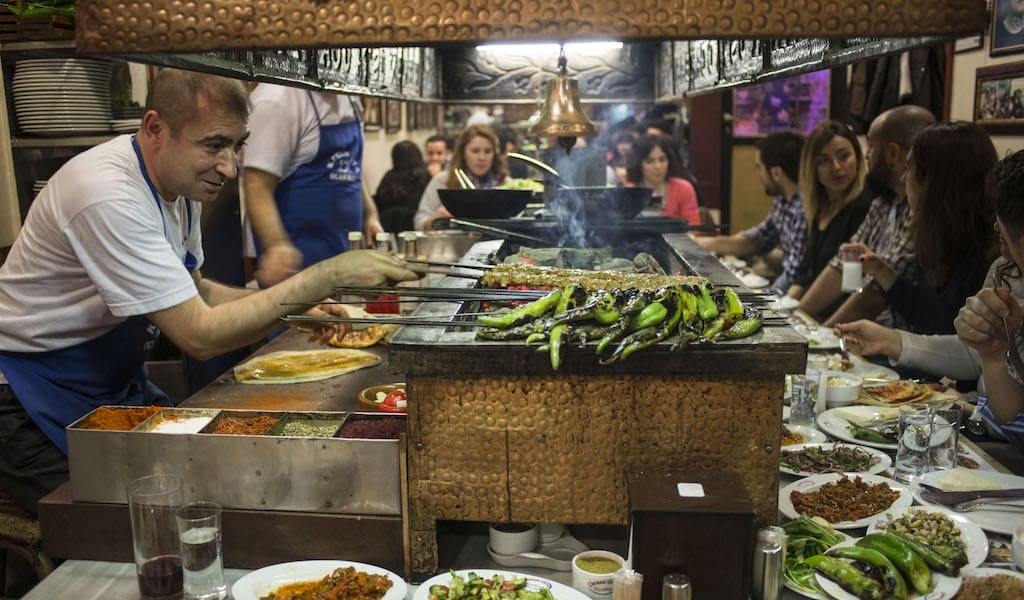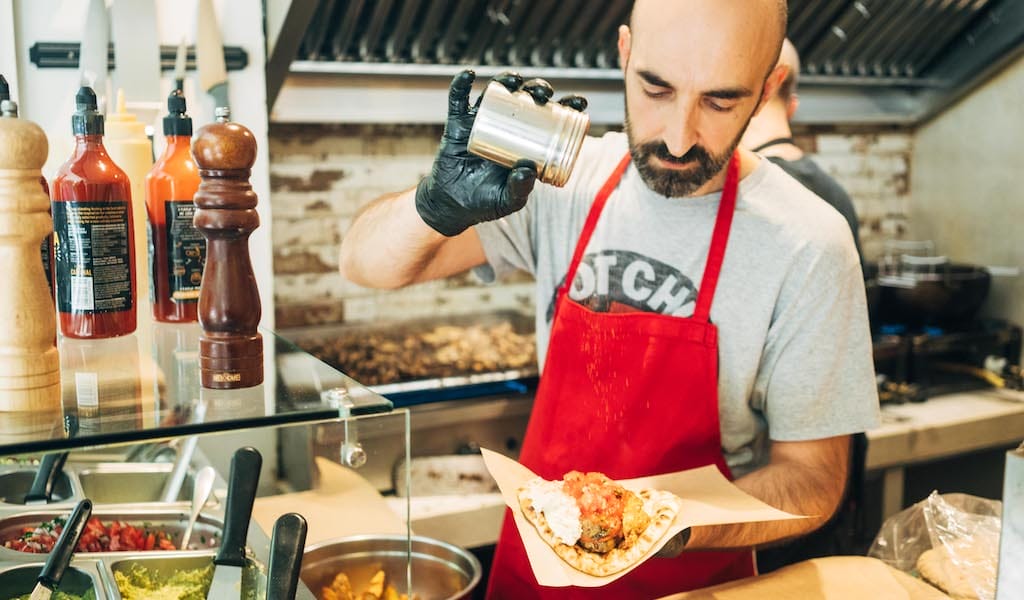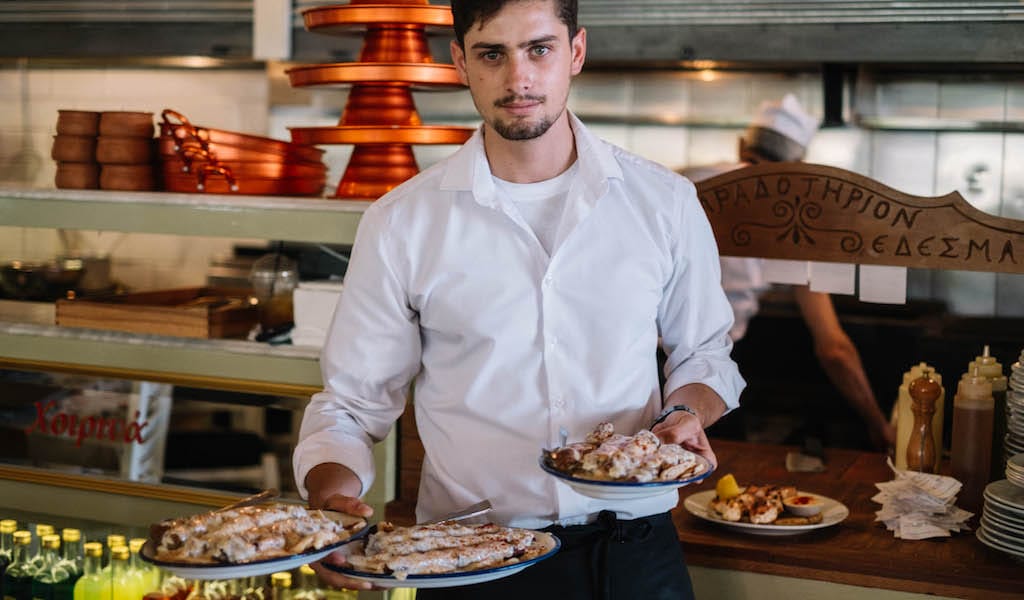If Istanbul had a city museum, in the 20th-century exhibition we’d expect to walk into a life-sized recreation of Kenan Usta Ocakbaşı, a seminal grill joint in the Beyoğlu district. As visitors descended a few steps into the exhibition, sensors would trigger the harsh light of fluorescent bulbs overhead, illuminating a room covered in photographs of husky men with mustaches posing with a stout man in an apron, grill master Kenan usta. The somber, groaning warble of the great Arabesque singer Müslüm Gürses would cue up in the visitors’ rented headsets and ducts inside the replica grill would belch out smoke scented authentically by grilled meat. Arrows on the floor would encourage visitors to sit down at one of the seats surrounding the large grill in the center of the room, across from a skewer-wielding rendering of Kenan usta himself. As the earphones filled with Kenan’s voice telling his own story of migrating from an Anatolian village to Istanbul as a boy and the hard-won modest success of this outsider – one that is as significant to contemporary Istanbul as the Hagia Sophia is to the skyline – the visitor to this exhibition would start to feel a mixture of pleasure and pain, amplified by an anise-scented sedative chemical released from the ducts.
The ocakbaşı, a grill house anchored by a long, copper-clad grill, may be a culinary destination for some, but we believe these spots are satisfying something beyond hunger, something emotional. Orhan Pamuk describes hüzün as “a state of mind that is ultimately as life-affirming as it is negating” and a state that is sought after. Pamuk’s description of hüzün-seeking reminds us of the mood in places like Kenan Usta. He and his crew of stodgy middle-aged waiters, through a long night of grilled meat chased by glasses of rakı, can reliably conjure that jinn of melancholy. But melancholy, like a hangover, is just a potential byproduct of a visit to this ocakbaşı.
To us, Kenan usta himself is as much a draw as his lamb chops. Pulling a chair up to his counter and spending the evening in the company of this usta, or “master” in Turkish, we must be seeking some little wisdom hidden in this life of struggle and gentle rebellion against assimilation and mass production – like the simple fortune cookie-like adages printed on the wall (“Trust and obedience bring discipline,” “Discipline brings peace of mind,” “Peace of mind brings success”). Sitting there, aren’t we hoping a little bit of Kenan will rub off on us? On one recent visit, Kenan usta said, “It’s not the heat of the grill in here, it’s from people.” Or as Musa Dağdeviren, the chef/culinary anthropologist who opened the landmark Çiya Restaurant, once told us: “An ocakbaşı should feel like you’re eating in someone’s kitchen at home. The conversation between you and the usta, it’s something else. It’s like psychotherapy.”
Kenan usta’s father moved him and his eight siblings to Istanbul from the central Anatolian town of Niğde in 1967 and found work as a hammal, or porter, in the city’s fruit and vegetable wholesale market. Kenan grew up hearing from his father that he could do anything he wanted in life, except be a porter in the market. At the age of nine, Kenan got his first job, washing dishes in the landmark 1001 Gece kebab house in Beyoğlu. After that he spent a few years at Kirvem, another classic neighborhood ocakbaşı, until finally he landed a job in 1977 at Erol Usta Ocakbaşı, working for several years as assistant to the respected Erol usta himself. “He taught me about hard work, respect, love and being human. And making good kebab – what else?” Kenan usta told us.
Erol’s kitchen was an usta incubator, and though a core crew of waiters, ustas and apprentices remained at his side until his death in 1995, many moved on to run their own kitchens elsewhere. In this way, the influence of Erol usta is felt all over town. After Erol died, the group lost its center and Kenan went back to Kirvem Ocakbaşı and worked the grill for 11 years. Finally, a dispute between him and the boss erupted and Kenan walked away, soon after opening his own shop just a few doors down from Kirvem.
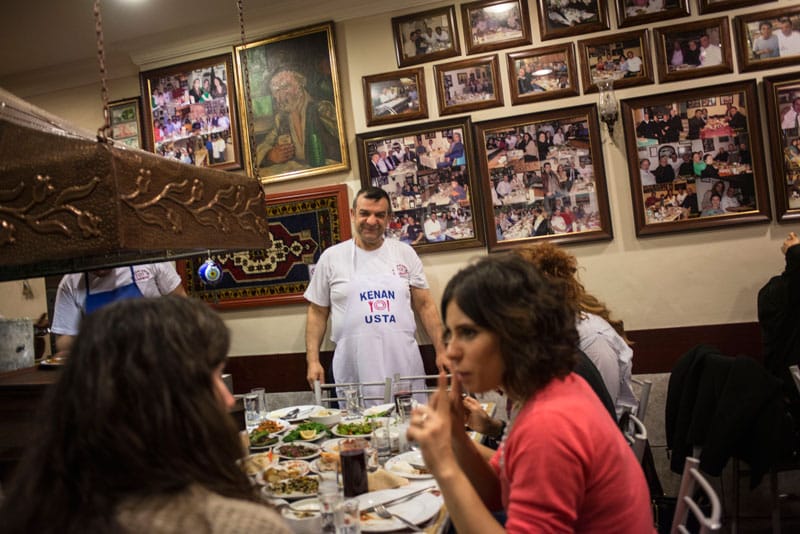
For 46 years without a break, Kenan usta has undertaken every task a kebab house might require right in this little network of streets below Taksim Square. “Aside from work, there’s nothing for us. If we’d stayed back in the village, I’d be picking onions and potatoes. We come from nothing,” he said. “I don’t believe in kismet. I work hard and I own my own fate. Otherwise I’d be lying around my house with a lottery ticket in my hand. Waiting for kismet.”
For most people in Istanbul, there’s a story like Kenan usta’s somewhere in their recent history. Statistically, there has to be. This city didn’t grow from 2 million to 17 million in 50 years on the heels of young, hip gentrifiers. Istanbul’s 20th-century story resembles that of Chicago or Detroit after the great migration of black southerners. For decades, bus after bus unloaded young, solo hayseeds sent to work, whole families were displaced, entire Anatolian villages dispersed and then tried to regroup piecemeal in the diaspora that is Istanbul. Some found the old, bluesy saying İstanbul’un taşı toprağı altın (Istanbul’s streets are paved with gold) to be true and made fortunes; most accepted their poor fortune as fate, driving cabs, working odd jobs or construction or maybe finding something steady for a while, if they were lucky, and repeating that phrase, cynically. And then there’s Kenan usta’s place, which, like a blues club on Chicago’s Southside, offers employment to recent arrivals but also provides a comfortable cultural outlet for otherwise disenfranchised migrants. The brotherhood at Kenan Usta, mostly together for the entire span of their careers, have chosen to plant a flag from Kebabistan right in the heart of Istanbul, signifying with all that grill smoke and red pepper their undeniable presence.
In the beginning – that is, the late 1960s – there were four ocakbaşıs in Beyoğlu: Pala, 1001 Gece, Sadık Usta and Erol Usta. These four restaurants, all crowded around each other in Beyoğlu, were the genesis of a type of restaurant that is now very much a part of Istanbul’s dining culture but was also an import to the city. Beyoğlu must have been an eerie place back then. Long the beating heart of non-Muslim minorities, where the vibrant nightlife and culinary scene was dominated by local Greeks (known as Rum), Armenians and Levantine families, it had an otherworldly atmosphere punctuated by brief but horrific spasms of anti-minority violence, leaving large pockets of the neighborhood abandoned, as those who could left the city or were forcibly exiled. According to a 2014 exhibition at Depo Istanbul on the 1964 expulsions, “20 Dollars, 20 Kilos,” some 60,000 local Rum residents were exiled in the span of a few months. No doubt a great number lived in Beyoğlu.
Alexander Senkopopovsky, a retired projectionist and self-proclaimed Istanbul “aborigine,” recalled the neighborhood right after the expulsions: “There was a sort of mafia around Beyoğlu. They’d go into the buildings, figure out which places belonged to Greeks who had left, and they’d put a hand on the place. Or there were open threats against [remaining] minority-owned businesses. People got scared and sold or just left. And then came the Anatolians.”
Some would say that Beyoğlu was no more, but really it was just changing hands. Şeref Acehan, a third-generation offal butcher in Beyoğlu, said, “The old İstanbullus come to İstiklal looking for the smell of chocolate….” The minorities of Beyoğlu are often associated with higher culture indicators – chocolate, fedoras, neckties. As nostalgic as it may be for something lost, it is yet another barb at the migrants who replaced them. Acehan continued, “…and all they smell now is kebab.”
When is a kebab just a kebab? A recent NYT article about France describes anti-immigrant sentiments dressed up as “kebabaphobia,” and in Istanbul it’s not so different or so subtle. Not long ago, there was an anti-kebab campaign (led by the fringe political group Türk Sol) aimed directly at Kurds. More recently, in an unforgettable column in a major daily Turkish paper, the writer scorns a tableau of hairy-assed Anatolians fanning kebab grills on the coastline. Migration from Anatolia may have overwhelmed the city, but a loud, vocal minority reluctant to accept its neighbors as citizens of the city remains.
In Beyoğlu in the 1960s the sentiments were largely the same. Senkopopovsky – whose own family arrived in Istanbul in 1917 with a wave of White Russian exiles fleeing their country’s revolution – explains, “[The migrants] were persona non grata. There was tension for a while – Don’t scream in the street; be a little more polite; you’re in Istanbul now, you know – until there were none of us left and they prevailed.”

Kenan usta hands over tender morsels of grilled meat, çöp şiş, wrapped in paper-thin lavaş, to those seated in front of him, by hand. He is friendly and humble to a fault. Kenan’s customers are either regulars or friends of regulars, it seems. Nobody is granted the luxury of anonymity. First-timers will ask Kenan where he’s from, and he’ll say Niğde. That customer will then share the place of his family’s origin, Zonguldak or Yozgat or Van, and then recall a teacher or a friend from military service who was from Niğde as well. Kenan won’t know that person, he explains. He left when he was just a boy. And with this ever-so-gentle introduction, everything is implied. Enough said. The fire is stoked. “We all came from some village. We can sympathize with each other,” he said.
From Erol usta, Kenan usta acquired his simple and unbending philosophy: no shortcuts. He personally selects everything he serves and all the food is made fresh to order. First come the mezes – eggplants roasted in the fire and mashed with garlic, a salad and a tangy cacık, an herbed yogurt and cucumber dish – followed by a chilled dish of black-eyed peas that you may or may not want but are served anyway.
Just as a second plate of the mashed eggplant seems like a good idea, the meat starts to roll out. Lamb chops and ribs; a walking stick-sized beyti, or kebab of spicy mince served on a long cutting board; grilled sweetbreads, spleen, liver and lamb’s heart. Chicken wings bathed in red pepper are always an option. Kenan will keep sending out more until you beg him not to.
For such a feast, it’s a mellow scene. People are not popping off selfies or singing along with the music so much as speaking closely and intensely, often with Kenan behind the grill. “Is anything missing, efendim?” Kenan usta will ask, beaming from across the grill.
“Sometimes I get tired but I have to keep smiling. I feel like a clown,” Kenan said. “But don’t misunderstand me, a clown can be a big person. Go to the funeral of a clown and everyone will be there.”
Editor’s note: Since so many people will be in town to celebrate the opening of the 15th Istanbul Biennial and myriad other art events, we thought it was worthwhile to rerun this 2015 article about one of our favorite dinner spots in Beyoğlu.
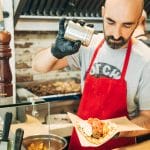 July 8, 2019 Cookoomela Grill
July 8, 2019 Cookoomela Grill
In the center of Exarchia, a hub of activism often referred to as the “anarchist” […] Posted in Athens July 20, 2018 Kyr-Aristos
July 20, 2018 Kyr-Aristos
The late Greek shipping magnate Aristotle Onassis may be world-famous, but no one could […] Posted in Athens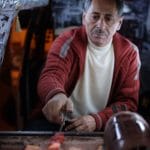 January 10, 2018 Yıldırım Usta’s Kebab
January 10, 2018 Yıldırım Usta’s Kebab
Kurtuluş Son Durak is a busy intersection and transit hub that’s a hive of activity 24 […] Posted in Istanbul, Street Food Masters
Published on September 14, 2017
Related stories
July 8, 2019
AthensIn the center of Exarchia, a hub of activism often referred to as the “anarchist” neighborhood of Athens, a small minimalist eatery with just a few tables outside opened last April and was an instant success by breaking all the rules. At first glance it looks like a regular souvlaki shop, with sauces and condiments…
July 20, 2018
AthensThe late Greek shipping magnate Aristotle Onassis may be world-famous, but no one could have guessed that he would be the source of inspiration for a neighborhood kebab place in a residential suburb of Athens. Onassis, who was commonly called Ari or Aristos, was born in 1906 in Smyrna (now Izmir, Turkey), only to later…
January 10, 2018
IstanbulKurtuluş Son Durak is a busy intersection and transit hub that’s a hive of activity 24 hours a day. Marking a transition between the tidy, middle-class Kurtuluş neighborhood and the rough-and-tumble quarters of Dolapdere and Hacıahmet, the area is home to a host of eateries and cafes that never seem to close. Right in the…







































